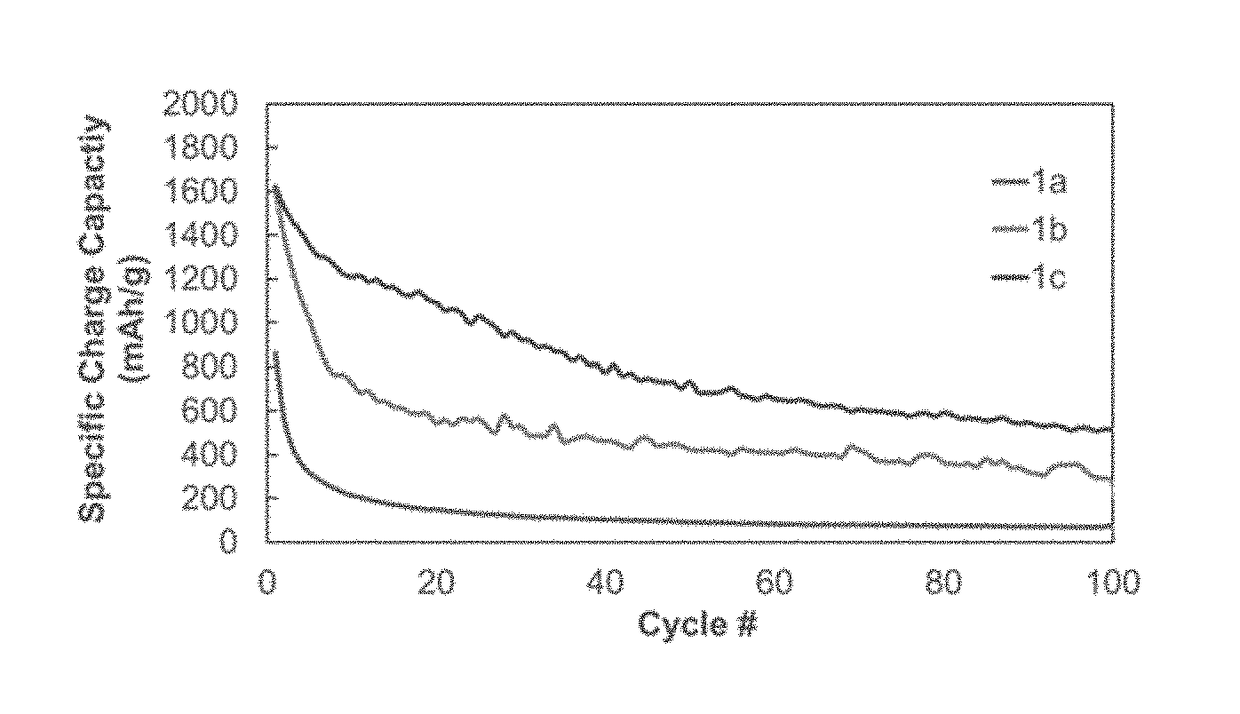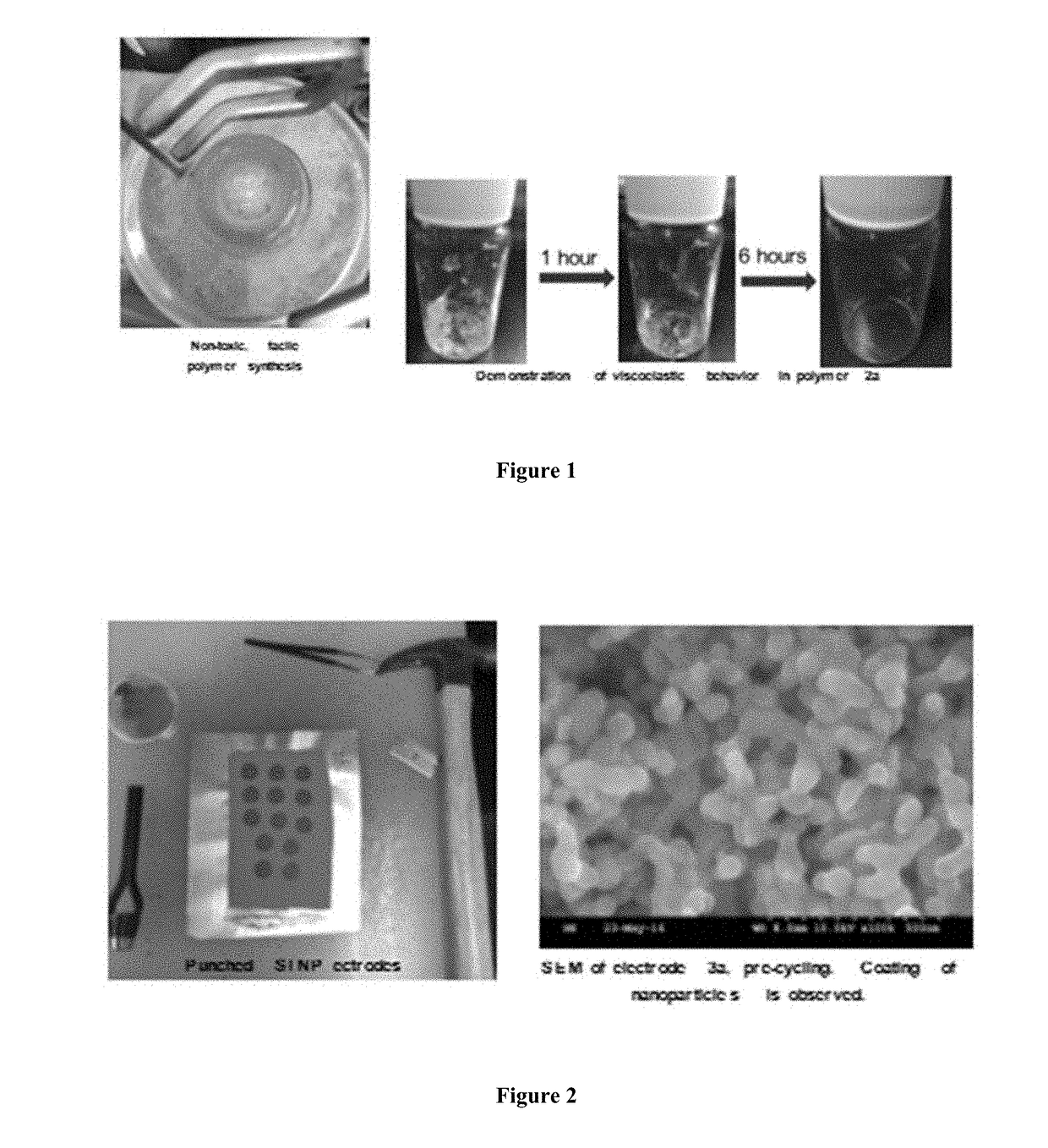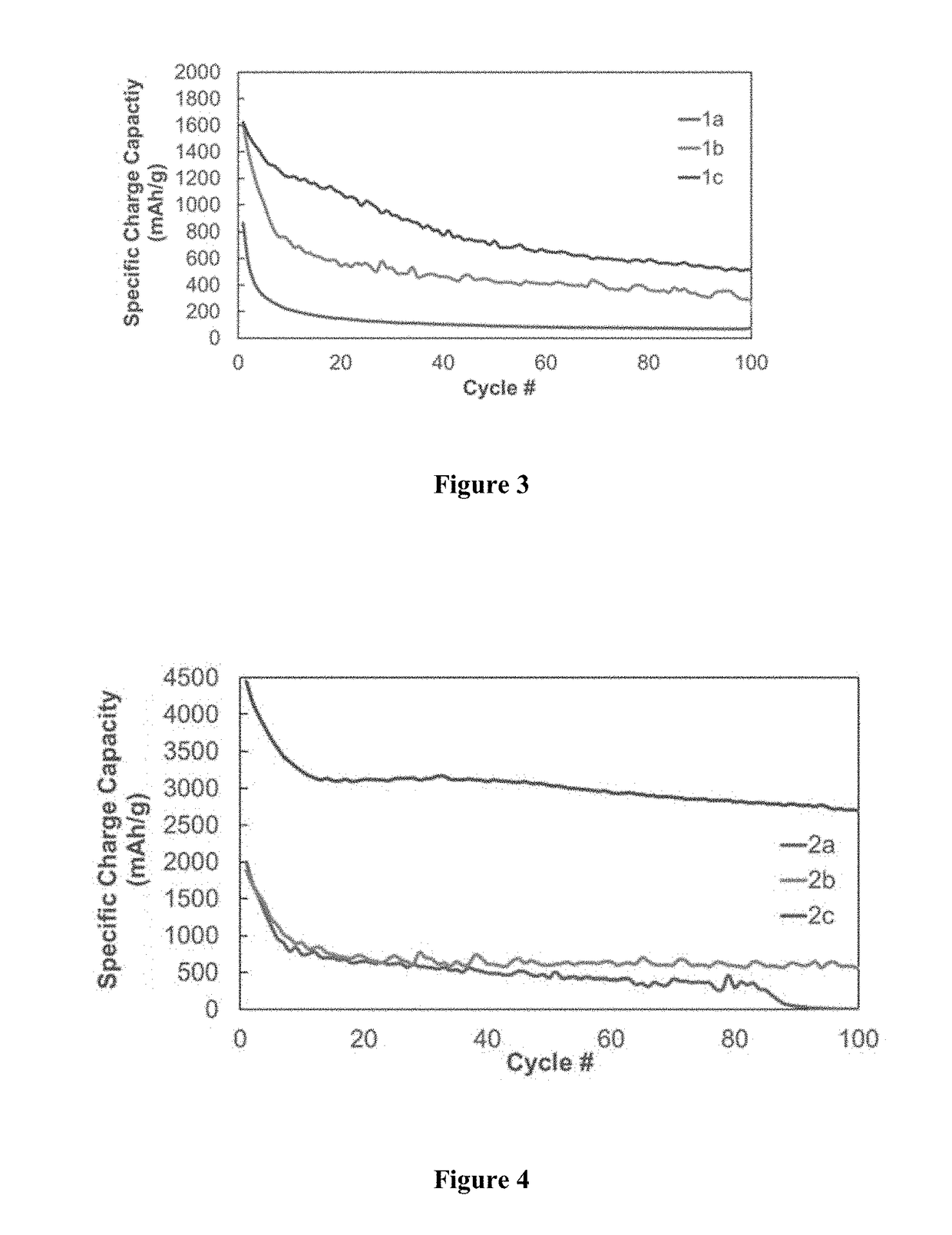Polyborosiloxane Binders
a polyborosiloxane and binder technology, applied in the field of polymer binders and their use in electrodes, can solve the problems of significant capacity loss, low production efficiency, and inability to produce commercially viable electrodes, and achieve the effect of retaining capacity
- Summary
- Abstract
- Description
- Claims
- Application Information
AI Technical Summary
Benefits of technology
Problems solved by technology
Method used
Image
Examples
example 1a
[0047]Polymers were synthesized via condensation reactions from a linear polymer, polysiloxane, and one or two cross-linking agents, TEPS and B(OH)3, depicted below.
[0048]As provided in Table 1, polymers of varying amounts of linear polymer, cross-linker a, TEPS, and cross-linker b, B(OH)3, were prepared.
TABLE 1Polymer Synthesis for 1a-3bLinear polymerCross-linker aCross-linker bPolymer(mass %)(mass %)(mass %)1a100——1b92.5—7.51c90—102a90552b8010102c5030203a—80203b*—8020*Cure-polymerized from monomers
[0049]Materials: Dichlorodimethylsilane (99%), boric acid (99.99%), and triethoxyphenylsilane (98%) were purchased from Alfa Aesar. Diglyme (>99.0%, no inhibitor) was purchase from TCI. Ethanol and dichloromethane (ACS grade) were purchased from Macron. Tetrahydrofuran was purchased from Acros Organics. Silicon nanoparticles of 30-50 nm average particle size were purchased from Nanoamor. Super65 carbon black was purchased from Timical. Battery grade LiPF6, EC, EMC, and FEC were purchased...
example 1b
[0061]Preparation of polymers 2-5: Preparation of PDMS, annotated here as polymer 1, was prepared as described in Example 1A. In the following experiment, Polymer 1, B(OH)3, and TEPS were added to a conical 50 mL flask with an oversized stir bar and brought to 190° C. over 1 h, then held for 14 h in open air. The resulting solid was dissolved in hexanes, filtered, and concentrated by rotary evaporation, then dried in a vacuum oven at 70° C. overnight.
TABLE 2Polymer Synthesis for Polymers 2-5Linear polymerCross-linker aCross-linker bPDMSTEPSB(OH)3Polymer(mass)(mass)(mass)22.858 g0.171 g0.157 g32.086 g0.267 g0.261 g41.363 g0.814 g0.544 g5— 3.48 g0.894 g
[0062]Polymer 2 (90% polysiloxane, 5% B(OH)3, 5% TEPS). 2.858 g Polymer 1a, 0.157 g B(OH)3, 0.171 g TEPS. Yield: 1.812 g (56.8%).
[0063]Polymer 3 (80% polysiloxane, 10% B(OH)3, 10% TEPS). 2.086 g Polymer 1a, 0.0.261 g B(OH)3, 0.267 g TEPS. Yield: 1.446 g (55.3%).
[0064]Polymer 4 (50% polysiloxane, 20% B(OH)3, 30% TEPS). 1.363 g Polymer 1a...
example 2
Preparation
[0066]Slurry solids were composed of a 3:1:1 mass ratio of silicon nanoparticles (30-50 nm avg particle size, 98% purity) to Timical Super65 carbon black to the above binder solution, where diglyme (TCI, >99.0%, no inhibitor) was used as the slurry's dispersive solvent. Homogenous suspensions of the above were prepared in scintillation vials by 5 hours of magnetic stirring in conjunction with periodic, 3×(5 minute) sonication. This suspension was cast onto copper foil and was spread with a doctor blade set at 50 micrometers, allowed to dry for 24 hours at atmospheric conditions, and cured over 24 hours in a vacuum oven at 135° C. Electrodes were punched by 14 mm die-cut lever press and immediately transferred to an argon-atmosphere glove box (FIG. 2).
PUM
| Property | Measurement | Unit |
|---|---|---|
| particle size | aaaaa | aaaaa |
| wt % | aaaaa | aaaaa |
| wt % | aaaaa | aaaaa |
Abstract
Description
Claims
Application Information
 Login to View More
Login to View More - R&D
- Intellectual Property
- Life Sciences
- Materials
- Tech Scout
- Unparalleled Data Quality
- Higher Quality Content
- 60% Fewer Hallucinations
Browse by: Latest US Patents, China's latest patents, Technical Efficacy Thesaurus, Application Domain, Technology Topic, Popular Technical Reports.
© 2025 PatSnap. All rights reserved.Legal|Privacy policy|Modern Slavery Act Transparency Statement|Sitemap|About US| Contact US: help@patsnap.com



